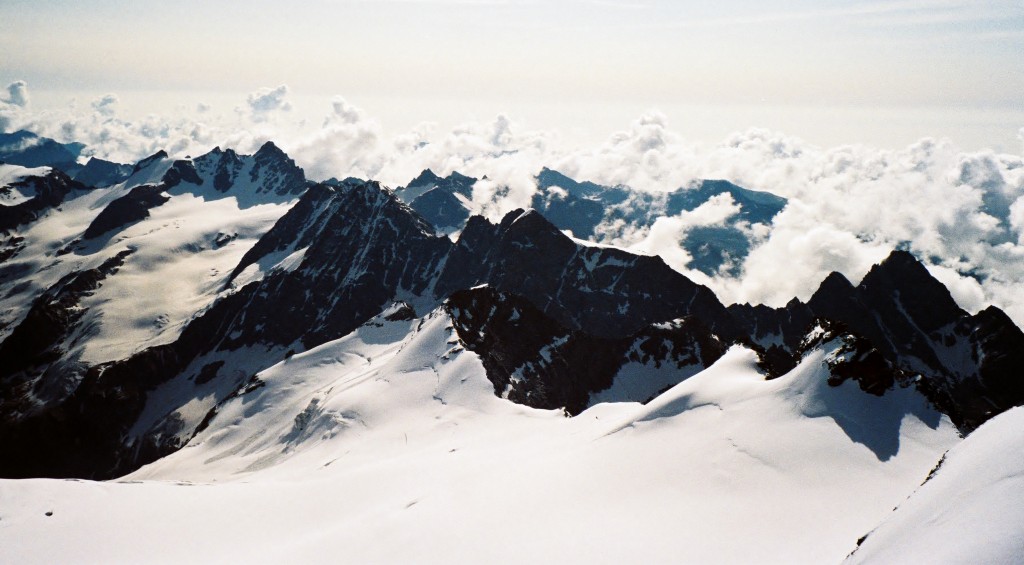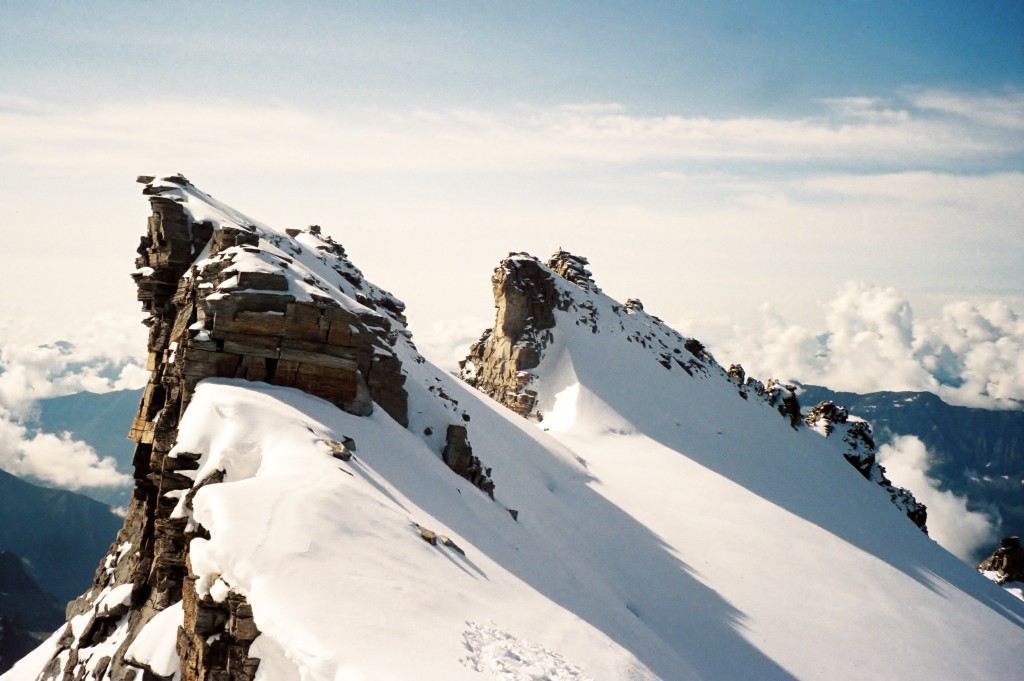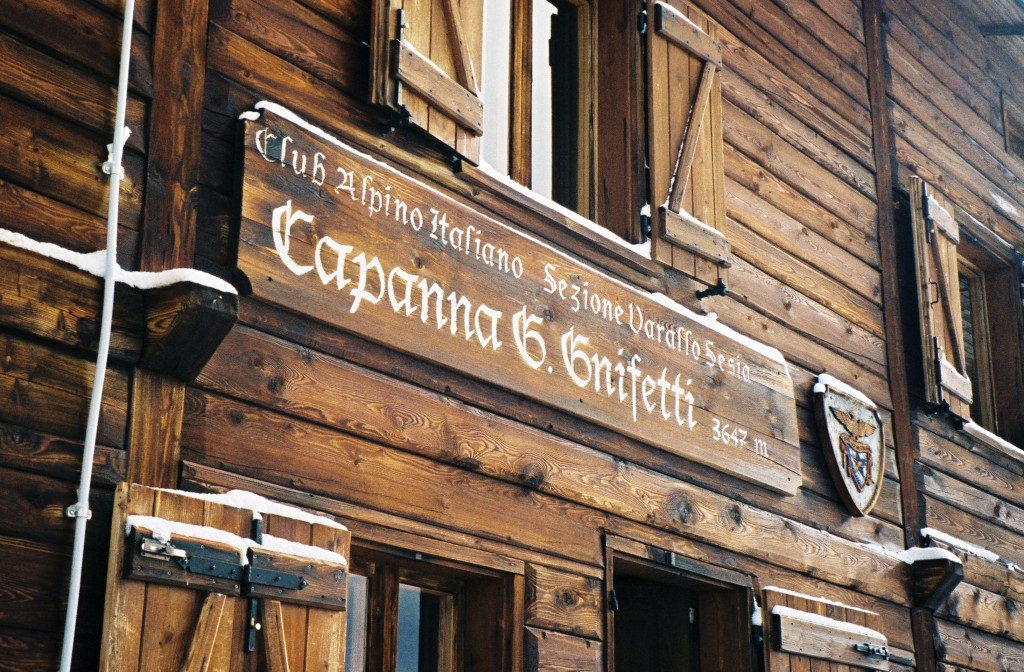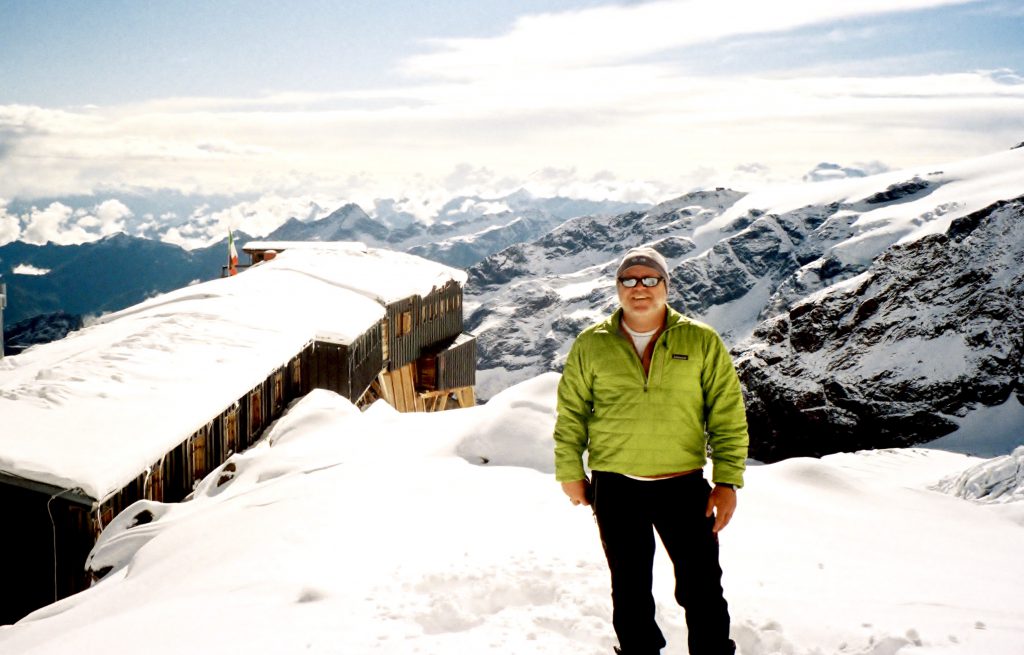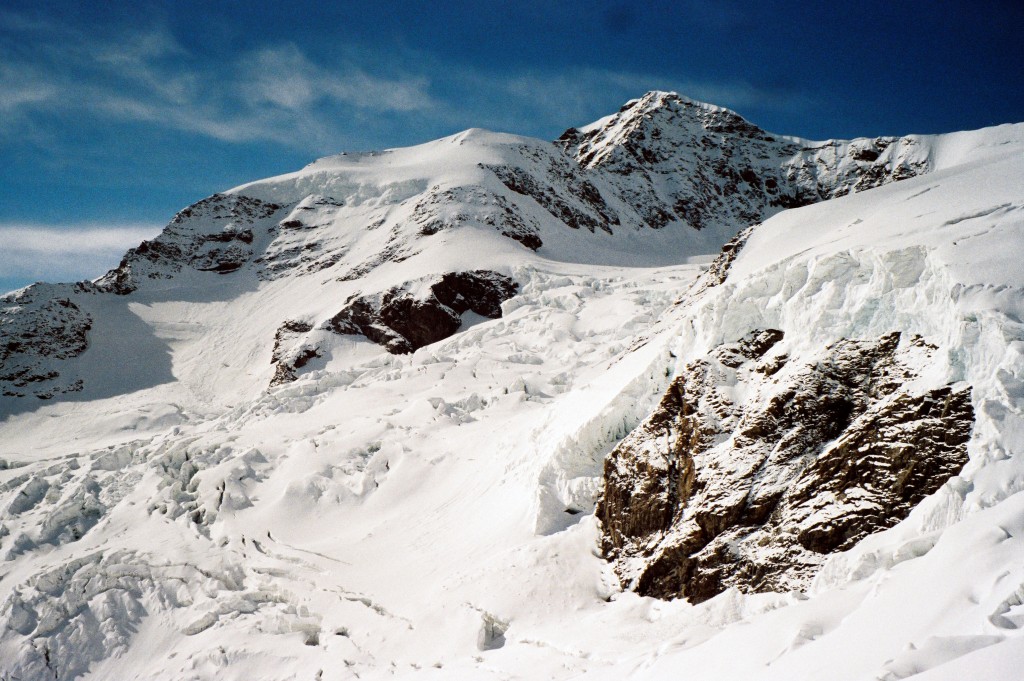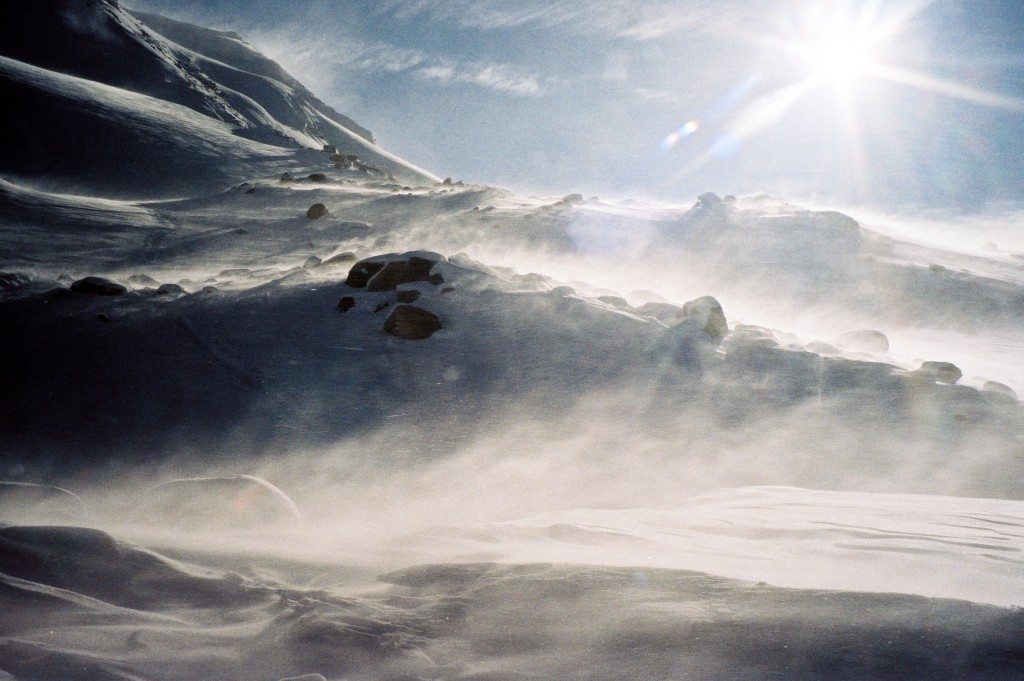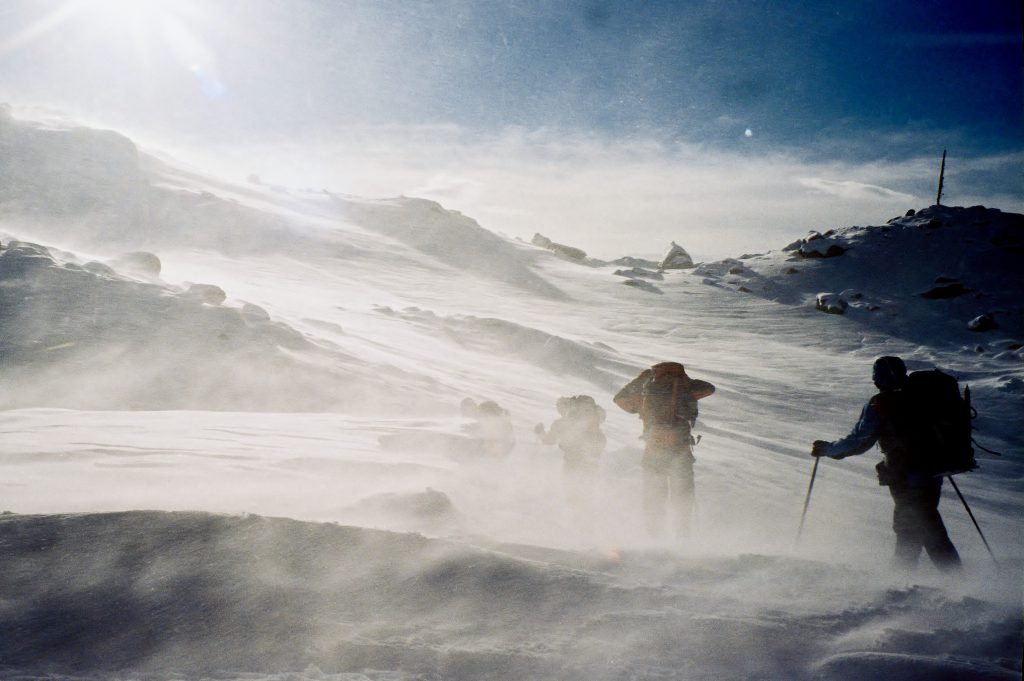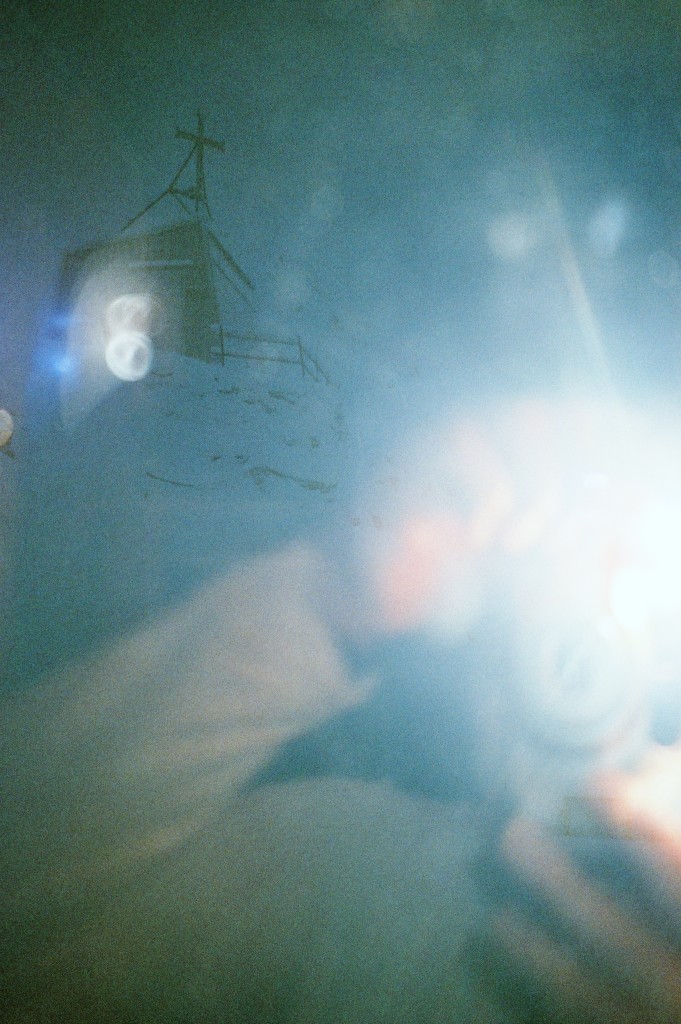A Deadly Season in the Alps
Orage – French for thunderstorm. Just one of the new words I’ve learned as the summer monsoon season in the Alps continues to drop new layers of snow with each day that passes. Historically, late July is the most stable time to climb in the Alps, but this year, as the snow line continues to lower and the precipitation accumulates, so do my French meteorological language skills: la grêle (hail), vents forts (strong winds), la foudre (lightening) – all becoming part of my everyday vocabulary.
It’s 9:30 p.m. as I sit in the comfortable 11,965 foot environs of the Capanna Gnifetti, I look out the window at the snow, now in large flakes, continuing to fall, cloaking this refuge which clings precariously to a tiny rock rib separating the Lys and Garstelet glaciers. The jumbled icefall alongside the hut provides a chilling backdrop for the Garstelet Chapel, the highest chapel in the Alps, and dedicated to “Our Lady of the Glaciers.” This small metal structure was built in 1967 to honor those who have fallen in the mountains with a service every 5th of August. Tonight its walls are silent. It is July 28 and the snow continues to fall.
The refuge is like an abandoned outpost as poor weather has kept away what would typically be a crowded mayhem of 175 of my newest climbing friends. Instead, I wander its voiceless hallways, sensing the 138 years of history as I page through old photos, books, and maps to pass the time. The silence is arresting as I lay on my bunk in a private room, a spoil awarded by the small numbers and a friendly smile.
I travel to the mountains to be in solitude and peace, and to feel at one with the nature around me. When the mountaineering becomes technical it requires a rope and a partner for safety. Up to this point, all of my sojourns in the high mountains have been with a partner. But for this trip I was compelled to go to the high mountains, the Alps, alone.
My intent was to do a 4,000 meter peak extravaganza beginning with Gran Paradiso, the highest mountain solely within Italy’s borders. I would acclimatize there and then head to the Monte Rosa massif for three days, staying the last night at the Margherita hut, the highest building in Europe at just under 15,000 feet. From there I had planned to tag as many of the 4,000 meter summits as I could on my way back. On the list were the spitzes, Zumsteinspitze and Parrotspitze, Schwarzhorn, Piramide Vincent, and Signalkuppe, atop which the four-story Margherita hut is perched above the clouds.
I knew these climbs would test me in ways I might not even know. But I was also secure in my skills and confident they could get me to the top – alone – and in good weather. I figured I would shoot a few hundred National Geographic quality photos, spend some contemplative time gazing at many of the peaks in the range, give a tip of the hat to the Mighty Matterhorn I climbed the previous year, and it would be the trip of a lifetime. But now, having dinner with a small gathering of Germans, Italians, and Swiss… we wait, anxiously peering out the windows turning over alternative scenarios in our minds.
This was just what I was doing earlier that day at the final lift station; considering alternative scenarios. I was fresh from a successful climb of Gran Paradiso, and although a bit depleted from the 7,000 vertical feet of climbing, I was acclimatized and eager for my next adventure to begin. Three lifts rise from the verdant valleys and alabaster cascades of Gressoney-La-Trinité to an unremarkable spot named Punta Indren at the base of the Indren Glacier. With each successive lift up, the weather deteriorated until I was welcomed by a full-on whiteout complete with Armageddon-like pouring rain. My climbing partner Rob has often remarked, the Maestro does not like being wet!
So, every few minutes I would stare into the void, hoping for improvement, but the rain continued to fall. It was now 3:30 p.m., only 90 minutes until the last lift could take me back to the comforts of the valley. To pass the time, a guide and six clients worked on the basics of glacier travel inside the remote and cold lift station, hoping for better weather. Occasionally a group of climbers would emerge from the grey mist, soaked down to their bones, grateful to have reached shelter.
It’s one thing to be standing with your partner trying to decide between adding another layer of Gore-Tex and heading into the whiteout, but quite another to be alone on unfamiliar terrain staring into the pouring rain, trying to decide to continue or retreat. With only a few minutes before the last lift down the valley, my mind was racing: Will I get lost in the whiteout? Will the rain make the glacier traverse unsafe? Can I make it to the hut? Can I ascend the fixed ropes in the pouring rain? What if I get halfway and need to turn back?
I waited, hoping for the rain to relent, or at least turn to snow. I calmed the anxious voices, and reminded myself that I can’t climb any mountain from the lift station. Eventually, taking steps into the unknown won out over an easy retreat. I had a good map, good verbal instructions from the guide book, and an hour’s hike to the refuge. After 20 minutes the rain turned to snow and the visibility worsened. The traverse across the glacier followed a well-worn track that eventually led to the rocks and a few painted blazes and cairns. At this point the path split, the lower trail leading to the Mantova hut, and the steeper path more directly to the Gnifetti hut. I opted for the lower, longer path to avoid the steeper way which now flowed heavy with water.
After about 30 minutes of traversing the wet rocks and steel cables, I was rewarded with a welcome site emerging from the mists and clouds. I could see both huts! From the Mantova hut, I could see only another 500 feet of climbing would take me to the Gnifetti hut. A few minutes later I was at the fixed ropes, using the rope for security while stepping on iron rungs called stemples to ascend the steepest rock sections below the refuge. Even in these conditions, with wet rock, slushy footing, and 2 inches of new snow, I was relieved to have made it.
Now, many hours later, with little hope from the last weather forecast, this handful of climbers inside the Gnifetti hut spend our time fortifying – our bellies, our minds, our resolve, and our patience. Who knows, maybe the storm will subside during the night, leaving just a dusting of snow. Maybe I’ll spend the next day at the hut, cancel my reservation at the Margherita Hut, and hope to climb the final day. It is all a waiting game now.
This is the reality of the mountains. What began months ago: planning, reserving huts, memorizing the route, setting itineraries, all happen with optimism and perfect weather. But it can quickly become a full on snowstorm, covering exposed crevasses, creating avalanche concerns, and making simple, easy terrain dangerous, uncertain, and unsafe for a solitary climber. On the glacier, you must read the conditions, know where to expect crevasses, and assess the level of risk that accumulates with each new inch of snow. So we continue to gaze out the windows and wonder. Will there be a safe weather window to tag a summit or two? Or ascend the 3,000 feet to the Margherita hut? Or do we just sit tight in the gathering storm and see what tomorrow brings, or the next tomorrow…
The snow continued through the night, finally clearing at 5:00 a.m. and leaving more than a foot of new snow. The obligatory early morning activity became the cold tiptoe in crocks and socks, carefully stepping to the edge of the terrace to take a few photos. Everyone spoke in hushed whispers, the snow giving the landscape a silent voice, speaking only intermittently to us through a cool breeze. Occasionally the clouds would clear revealing an unparalleled beauty transformed by this new layer of glacial frosting.
The snow blower was unwilling to awake from its summer slumber. So began the three hours of shoveling the many steps, terraces, tables, and paths of this ancient structure. Two hearty souls took advantage of the break in the weather to begin reclaiming the track across the Garstelet Glacier. Just above the hut is a dangerous crevasse zone and having the track in now would save a lot of time the next morning. Several of us watched the progress as their herky-jerky dance across the snow ensued: a step up past the knees, the wobbly placement of a trekking pole, the lean, and another step as they post-holed their way to the next stumble and the inevitable fall. Then the whole cycle repeated itself again and again: step, sink, pole, lean, fall. After two hours, the suffering got the best of them and they returned. The shoveling continued.
The weather forecast for tomorrow, and the next day, is improving. But by 11:00 a.m. the skies are once again white, leaving us another inch to ponder. Instead of the planned night at the Margherita hut, I elect to remain in my private room and wait out the weather, hoping for a hard freeze and clear skies in the morning. Perhaps tomorrow I can make it to Signalkuppe and back down in time for the last lift to Gressoney. Or maybe I can at least summit nearby Piramide Vincent, a peak often climbed from the hut in unsettled weather – it is all a waiting game now.
By late afternoon my wait is rewarded with a remarkable clearing all the way down the valley to the Italian Piedmont. Many of us line the terrace and enjoy the view, trying not to notice the bad weather continuing above us, and instead, focus on the long line of climbers making their way to the hut. With the promise of improved weather my abandoned hut fills to overflowing, and with that comes a barrage of questions. Where are you from? What were you planning to climb? What are you planning now? How many days before you have to go back down? Has anyone returned from the Margherita Hut yet? How early are you going to leave in the morning?
No matter the question, it’s really all about the track. The track is the route that winds its way around crevasses and takes the safest route to the many peaks above. By mid-season, the tracks have been beat into the snow by countless sets of cramponed boots until the footing is easy and efficient. With a hard overnight freeze, the track becomes firm enough that each crampon sounds like it is stepping on a new piece of Styrofoam – a sweet sound to a mountaineer. But now, with well over 4 feet of new, wet, heavy snow, the track is gone. It’s filled with new snow, requiring a lot of effort post-holing, searching for crevasses, and slow, suffer-filled steps to put the new track in. No one wants to be the first group breaking trail in this deep, wet snow. And I, being a solo climber, prefer to be in the middle of the pack when we all set out in the pre-dawn light.
I awake to surprisingly clear skies. Windy, but clear. Typically breakfast at 4:30 a.m. is a frantic time with every seat full. Climbers hurriedly inhale the standard hut breakfast of old crusty bread with congealed jams, drink their coffee in large bowls, and then make a mad dash to be out and on their way. This morning, there is a leisurely quality I have never experienced before. People are talkative. Having a second bowl of coffee. Seemingly not in a rush at all. I head upstairs to see how many have started their way up – not a one! You see, it’s still all about the track – and no one wants to be first.
Looking up the glacier toward Piramide Vincent, I can see that the track now has been completely obliterated, no trace of what was there last evening. While the sky is clear, the wind is gusting at something just a little less than a jet engine. By about 6:00 a.m., a queue of climbers finally begin their ascent and the arduous job of breaking trail through the snow. I pack up, put on every layer I own, and begin my adventure for the day. It’s a bit windy at first, but once I passed the chapel and start down the steep incline to the glacier I realized the hut had been blocking most of the wind. Out in the open the wind is fiercely howling down the mountain. With no hard freeze overnight, each step I took went well past my knees. It was arduous progress, and the incredible winds swirling around me, were making the suck factor spike in ways I hadn’t imagined before. Now I have been in windy places many times. I have been wet and freezing, in whiteouts, hail, thunder, and lightening. As a mountaineer, you just shrug it off as “enjoying another day in the mountains,” add an extra layer, and just keep moving. But this particular vents forts would make even the most hardened mountain man wonder just what the hell he was doing here. With each gust, I stop and lean into my ice ax as the wind whips down the glacier bringing a chilling vortex and making each step seem futile.
As I looked up toward the saddle, I noticed that our International Delegation of Climbers, once zippy and quick under clear skies, was slowing a great deal. The space between the teams was tightening up as the winds increased and visibility worsened. Our line of 20 or more climbers was getting slower and slower to where there was less than 10 feet between groups. The wind, now the lead player in our little drama, was blowing the track completely clean by the time the next climber took a step.
I am not sure if it was snowing again, or just blowing, but our clear skies had now become a full on blizzard. Above us, the visibility was a seemingly impenetrable opaque gray-white wall. By now, the line of climbers had nearly slowed to a stop. I began to reevaluate the weather, predicting what the conditions might be like higher and how they might be hours from now. Would I make it to the top just to get lost in whiteout conditions on the way down? Maybe I should throw in the towel and just summit Piramide Vincent once I reach the saddle. Decisions need to be made.
I think every climber has that inner voice. A subconscious. A feeling. Perhaps it’s instinct, maybe it’s just anxiety or fear, but it is present whenever important choices need to be made. It’s no secret that mountain climbing is dangerous. Climbing is an activity with inherent risk. But what is too much risk? This is a question that each must answer for themselves. Our inner voice helps us to minimize the risks, and to look at the weather and conditions soberly, without the emotion that can cloud decision making.
Just above the crevasse system, I look up toward Piramide Vincent and eye the conditions. Foremost in my mind are some of the red flags of avalanche danger: unstable snow as you travel, heavy snowfall or rain in the last 24 hours, significant warming or rapidly increasing temperatures, and the presence of strong winds after a large snowfall. Winds can compact and bond the snow into wind slabs which can be very unstable. I have turned around many times in the mountains, and while I’ve occasionally bailed prematurely, it’s generally been the right decision. So with an enormous number of reasons to turn back, and not one to continue, I turn around. On the way back, a friend offers for me to join their rope headed up. While I appreciate this generous offer, I’m at peace with my decision.
The first few steps seem like I have given up, that I am overreacting to the conditions, but as I continue back to the hut, the wind seems to actually worsen. The snow pelts my face and neck as I put on another pair of gloves. I watch the teams headed my way, their expressions more of dread than resolve. I look back up the mountain and I know that I will be at this very place again, someday, in better conditions.
As I arrive back at the hut, I’m surprised to see that no one has broken the trail down to the lift station. Perhaps it is just the cold wind freezing my n#*ts off, or just a strong desire to get home, but suddenly my confidence seems to be brimming. I look down the steep rock section, now completely hidden by snow, and the 55 degree snow traverse that will require some extra careful footwork. Without a pause, I begin descending the fixed ropes. It doesn’t take long before a small group follows. I guess just to make me feel better about my decision, the wind continues to howl and beat on us all the way down to the lower hut. Every time I look back, the wind gusts so forcefully that the snow makes it impossible to see anything as everything quickly disappears into a world of whiteness. Yet with each step forward the conditions improve, and soon I am back in the dark lift station where this whole journey to nowhere began three days ago.
The next day on Pyramide Vincent an Irish climber was killed, and an American mountain guide was being treated for hypothermia, after they were swept into a crevasse by an avalanche. It was the very spot where I had turned around the day before. Two helicopters and 20 members of the Aosta Valley Alpine Rescue Team were on the scene and reported at least three more avalanches during the search. The same week, two climbers fell to their deaths on Dent du Géant, on a famous ridge I climbed in 2009. Not long after, six climbers were found dead on Aiguille d’Argentiere. They were climbing the same Flèche Rousse route I had climbed in 2012.
On August 5th, the tiny chapel next to the Capanna Gnifetti held its service to honor those who had lost their lives in the mountains this year – a tragic year. “Our Lady of the Glaciers” has seen much sorrow in her time atop her lofty pinnacle. While countless pages have been written about the tragedies in the mountains, few pages are written about the climbing experiences that make you a better person, that give you a perspective which deepens your appreciation for everything around you. Non-climbers will always wonder why climbers continue, in spite of the inherent risks, to keep searching out summits and traveling into these remote worlds of rock, ice, and snow.
Death, and your proximity to it, forces you to evaluate your own feelings about death. It is surely coming to us all, so I choose to live life to the fullest until that time, always saying yes to adventure, something quickly eroding from our human experience. Yet I know when to say no for safety. There is an old saying that goes, “a famous climber dies young, but a great climber dies of old age.” I vote for the latter.
We gained a deep appreciation for our lives, the people in them, and the wonders of the natural world. In risking everything, our lives gained new dimensions of experience and adventure, and we also learned in a deep way that life is fleeting and that it is important to live our lives in the best possible manner at every moment, cherishing those we love.
– Arlene Blum, member of the all-women ascent of Annapurna


